20. Sample Return
This sample return uses actual forms to show you how to prepare your
income tax return. However, the information shown on the filled-in forms is not
from any actual farming operation.
Walter Brown is a dairy farmer and his wife, Jane, is a substitute teacher for the
county school system. They have three children. Their return has been prepared using the
cash method of accounting. See chapter 3 for an explanation of the cash method and other
methods of accounting.
Rounding off to whole dollars. You may round off to the nearest
whole dollar on your return and schedules. This will make it easier to complete your
return. To do so, drop amounts under 50 cents and increase amounts from 50 to 99 cents to
the next dollar. For example, $129.49 becomes $129 and $235.50 becomes $236.
If you do round off, do so for all amounts. However, if you have to add two or more
amounts to figure the total to enter on a line, include cents when adding the amounts and
round off only the total.
Losses from operating a farm. The sample return shows a profit from
the operation of the farm. However, if your deductible farm expenses are more than your
farm income for the year, you have a loss from the operation of your farm. If your loss is
more than your other income for the year, you may have a net operating loss (NOL). You may
also have an NOL if you had a personal or business-related casualty or theft loss that was
more than your income.
If you have an NOL this year, you may be able to reduce your income (and tax) in other
years by carrying the NOL to those years and deducting it from income.
To determine if you have an NOL, complete your tax return for the year. You may have an
NOL if a negative figure appears on line 39 of Form 1040. If this is the case, see Losses
From Operating a Farm in chapter 5.
Preparing the Return
Schedule F (Form 1040)
The first step in preparing Mr. Brown's income tax return is to determine his net farm
profit or loss on Schedule F. The income and expenses shown on this Schedule F are taken
from his farm receipt and expense records. Data for the depreciation and section 179
deductions are taken from Form 4562 and the illustrated Depreciation Worksheet that
follows Form 4562. Mr. Brown has filed all required Form 1099 information returns.
On line B, he writes the number 112120 from the list of Principal
Agricultural Activity Codes on page 2 of Schedule F (not shown). This indicates that
his principal source of farm income is from dairy farming.
Schedule F - Part I (Income)
Mr. Brown keeps records of the various types of farm income he receives during the
year. (Farm income is discussed in chapter 4.) He uses this information to complete Part I
of Schedule F.
Line items. He fills in all applicable items of farm income.
Line 1. In 2002, he sold steers he had bought for resale.
He enters sales of $26,584.
Line 2. He enters the cost of the steers, $6,523. He has
kept a record of the cost of the livestock he bought and is careful to deduct the cost of
an animal in the year of its sale.
Line 3. He subtracts his cost on line 2 from the sales on
line 1 and reports the difference, $20,061, as his profit on line 3. Had he sold any other
items he bought for resale, he would combine the sales and costs of these items with the
sales and costs of the steers and report only the totals on lines 1, 2, and 3. He does not
report here sales of livestock held for draft, breeding, sport, or dairy purposes. He
reports those sales on Form 4797.
Line 4. He enters the income he received during 2002 from
sales of items he raised or produced on his farm. His principal source of farm income is
dairy farming. The amount reported on this line, $213,018, includes sales of all of the
following.
| Milk |
$183,874 |
| Steers and calves he raised |
2,914 |
| Vegetables he grew |
1,457 |
| Corn ($7,286), hay ($8,944), and wheat ($8,543) he raised |
24,773 |
| Total reported on line 4 |
$213,018 |
Lines 5a and 5b. He reports the $33 he received from
cooperatives on line 5a. Since this is the dollar amount of a qualified written notice of
allocation paid as part of a patronage dividend, he enters $33 as the taxable amount on
line 5b.
Lines 6a and 6b. He received Farm Service Agency (FSA)
cost-sharing payments of $438 on a soil conservation project (diversion channels)
completed in 2002. He received the income as materials and services paid for by the
government and reports it on both line 6a and line 6b. The Department of Agriculture
(USDA) generally reports such payments to the recipient on Form 1099-G. The entire $438
has been included on line 14 of Schedule F as a conservation expense. He did not receive
any cost-sharing payments this year that he could exclude from his farm income.
Line 7a. He reports the $665 loan he received from the
Commodity Credit Corporation (CCC) because he elected in a previous year to treat these
loans as income in the year received. (If he had elected not to report his CCC loan as
income in the year received and forfeited the loan in a later year, he would report the
loan as income on lines 7b and 7c in the year of forfeiture.)
Line 9. He reports his $1,258 of income from custom
harvesting.
Line 10. On his 2001 income tax return, he claimed a credit
of $142 for excise taxes on gasoline used on his farm. He includes the entire $142 in his
2002 income on line 10 because he deducted the total cost of gasoline (including the $142
of excise taxes) as a farm business expense in 2001. He also includes $250 he received as
a director of the local milk marketing cooperative and $175 received for firewood he cut
and sold in 2002.
Schedule F - Part II (Expenses)
Mr. Brown records his farm expenses during the year for tax purposes and summarizes
these expenses at the end of the year. (Farm business expenses are discussed in chapter
5.) This gives him his deductible expenses, which he enters in Part II of Schedule F.
Line items. He fills in all applicable items of farm expense
deductions.
Line 12. He uses his trucks 100% for his farming business
and the actual cost (not including depreciation) of operating the trucks in 2002 was
$2,659. He uses his family car 60% for business (determined by records at year end). It
cost $2,307 to operate the car in 2002. He can deduct $1,384 for the car ($2,307 × .60).
He enters a total of $4,043 ($2,659 + $1,384) on line 12. (Depreciation is reported on
line 16.)
Line 13. The $2,701 on this line is the amount he paid for
pesticides and herbicides purchased during the year.
Line 14. He deducts the $1,040 spent on diversion channels
in 2002. The amount listed here includes the full cost of the government cost-sharing
project, which he has reported as income on line 6. He continues the policy elected in
previous years of deducting annual soil and water conservation expenses. The expenses are
consistent with a conservation plan approved by the Natural Resources Conservation Service
of the USDA.The amount was not more than 25% of Mr. Brown's gross income from farming, so
the entire amount is deductible. See chapter 6 for more information on soil and water
conservation expenses.
Line 15. The $1,575 on this line is the amount he paid a
company for spraying his crops. He made the payment to a corporation, so he does not file
a Form 1099-MISC to report the payment.
Line 16. He enters the $80,621 depreciation from Form 4562,
discussed later.
Line 18. He enters the $18,019 cost of feed bought for
consumption by his livestock in 2002. He did not include the cost of feed bought for
livestock he and his family intend to consume. He also did not include the value of feed
grown on his farm.
Line 19. He enters $6,544. This is the amount paid for
fertilizer and lime.
Line 20. He deducts the $5,105 he paid for trucking and
milk marketing expenses. He chose to itemize the $807 government milk assessment and lists
it separately on line 34a.
Line 21. He deducts the $3,521 cost of gasoline, fuel, and
oil bought for farm use, other than amounts he included on line 12 for car and truck
expenses. He did not deduct the cost of fuel used for heating, lighting, or cooking in his
home.
Line 22. He deducts the $1,070 cost of insurance on his
farm buildings (but not on his home), equipment, livestock, and crops. He did not deduct
the entire premiums on 3-year and 5-year insurance policies in the year of payment, but
deducts each year only the part that applies to that year. For more information, see Insurance
in chapter 5.
Lines 23a and 23b. He deducts on line 23a the $3,175
interest paid on the farm mortgage for the land and buildings used in farming. He deducts
on line 23b the $1,043 interest paid on obligations incurred to buy livestock and other
personal property used in farming or held for sale. He deducts his home mortgage interest
on Schedule A (Form 1040), which is not shown.
Line 24. He enters the $16,416 in wages he paid during the
year for labor hired to operate his farm, including wages paid to his wife and children.
He did not include amounts paid to himself. He has no employment credits that would reduce
the amount of wages entered. For those wages paid that were subject to social security and
Medicare taxes, he included the full amount of the wages before reduction for the
employee's share of those taxes, or other amounts withheld. His share of the social
security and Medicare taxes is included in the total taxes deducted on line 31. See
chapter 16 for information on employment taxes.
Line 26b. He enters only the $2,400 cash rent paid for the
use of land he rented from a neighbor, Mr. Green. He did not deduct rent paid in crop
shares. He completed a Form 1099-MISC for the rent paid to Mr. Green and sent Copy A to
the IRS with Form 1096. He gave Mr. Green a copy of the Form 1099-MISC.
Line 27. The $5,424 he enters includes $4,902 for repairs
to farm machinery and $522 for repairs to farm buildings. He did not include the value of
his own labor or the cost of repairs on his home. He prepared Form 1099-MISC for the farm
machinery repairs because the repair shop is a limited liability company (LLC) that is not
classified as a corporation. He sent Copy A to the IRS with Form 1096 and gave a copy to
the owner of the repair shop. If the repair shop had been a corporation, Mr. Brown would
not have had to file a Form 1099-MISC. He does not have to file a Form 1099-MISC for the
building repair because he paid less than $600.
Line 28. He enters the $2,132 cost of seeds and plants used
in farming. He deducts these costs each year. He did not include the cost of plants and
seeds purchased for the family garden.
Line 30. He enters the $2,807 paid for livestock supplies
and other supplies, including bedding.
Line 31. He enters $3,201 for taxes paid during 2002,
including state and local taxes on the real estate and personal property used in farming.
He did not include the sales tax paid on farm supplies because this tax was included in
the cost for supplies he deducted on line 30. He also did not include the gasoline tax on
the gasoline bought for farm use, including the gasoline used in his trucks and family car
for farm business, because these taxes were included in the costs for gasoline he deducted
on lines 21 and 12. He included his share of social security and Medicare taxes paid for
agricultural employees. He filed Form 943 (not shown) in January 2003, reporting these
taxes for calendar year 2002.
He does not deduct, on Schedule F, his state income tax or the taxes on his home and
the part of his land not used for farming. He deducts these taxes on Schedule A (Form
1040), which is not shown. He does not deduct any federal income tax paid during the year.
Line 32. He enters $3,997 for the cost of water,
electricity, gas, and telephone service used only in farming. He cannot deduct personal
utilities. He also cannot deduct the cost of basic local telephone service (including any
taxes) for the first telephone line to his home.
Line 33. He enters $3,217, the total paid during 2002 for
veterinary fees ($1,821), livestock medicines ($650), and breeding fees ($746). He does
not prepare Form 1099-MISC for the veterinarian and the supplier of breeding services
because both are incorporated.
Line 34. He enters other farm business expenses. These
include: an $807 government milk assessment; $347 for commissions, dues, and fees; $287
for financial records and office supplies; and $534 for farm business travel and meals.
Farm business travel includes expenses for the State Forage Tour and for attending the
farm management conference at State University. He included only 50% of the cost of meals
in the deduction.
Line 36 - Net farm profit. To arrive at his net farm
profit, he subtracts the amount on line 35 ($170,026) from the amount on line 11
($236,040). His net farm profit, entered on line 36, is $66,014. He also enters that
amount on line 18 of Form 1040, and on line 1 of Section A, Schedule SE (Form 1040).
Because he shows a net profit on line 36, he skips line 37.
Form 4562 - Depreciation
and Amortization
Mr. Brown follows the instructions and lists the information called for in Parts I
through IV. He also completes Part V on page 2 to provide information on listed property
used in his farming business. The three vehicles used in his business are listed property.
The truck, sold in July and shown on Form 4797, was placed in service in 1993 and fully
depreciated in 1998. No depreciation is allowed for 2002.
Depreciation record. He records information on his depreciable
property in a book that he can use to figure his depreciation allowance for several years.
He uses the Depreciation Worksheet from the Form 4562 instructions to figure his
2002 deduction.
Basis for depreciation. He bought his farm on January 8, 1978.
Timber on the farm was immature and had no fair market value (FMV). He immediately
allocated the total purchase price of the farm among the land, house, barn, and fences (no
other capital improvements were included in the price of the farm). He made the allocation
on the purchase date in proportion to (but not in excess of) the FMVs of the assets and in
the required asset order. See Trade or Business Acquired in Publication 551 for
more information.
He entered in his depreciation record the part of the purchase price for the
depreciable barn and fences, giving him the basis for figuring his depreciation allowance.
The fences were fully depreciated in 1987. Because he cannot depreciate the house and
land, he keeps a separate record showing their bases.
Methods of depreciation. He depreciates all his property placed in
service before 1981 using the straight line method. He chose the alternate Accelerated
Cost Recovery System (ACRS) method for his machine shed placed in service in 1986. He
chose the following systems for all of his assets placed in service in the year indicated
using the Modified Accelerated Cost Recovery System (MACRS) and the half-year convention.
- 1998 - straight line Alternative Depreciation System (ADS).
- 1999 - 150% declining balance ADS.
- 2000 and 2002 - 150% declining balance General Depreciation System (GDS).
Depreciable property. One of his purchased dairy cows (#42) was
killed by lightning in July 2002. Two other purchased cows (#52 and #60) were sold in
2002. The cows were depreciated under MACRS (ADS), using a half-year convention.
Therefore, he can claim a half-year's depreciation for each cow in 2002.
He has other breeding and dairy cows he raised. He did not claim depreciation on them
since his basis in the cows is zero for income tax purposes.
During 2002 the Browns owned two family cars. One of them was not used for farm
business. Mr. Brown cannot deduct depreciation on it. Based on his written records, he
determined at the end of the year that his other car was used 60% for his farm business
and 40% for personal driving.
The Depreciation Worksheet contains an itemized list of Mr. Brown's assets for
which he is deducting depreciation in 2002. He must list each item separately to keep
track of its basis. The pickup truck and car purchased in 1999 are listed property in the
5-year property class.
New assets. Mr. Brown added three assets to his farming
business in 2002.
- In January, he completed and placed in service a dairy facility designed specifically
for the production of milk and to house, feed, and care for dairy cattle (single purpose
livestock structure). The building is depreciated separately from the milking equipment it
houses. The cost of the building is $56,500 and it is 10-year property under MACRS. The
cost of the equipment is $72,000 and it is 7-year property under MACRS.
- In February, he made improvements to his machine shed for a total cost of $1,300. The
improvements are depreciated as if they were a separate building with a 20-year recovery
period.
- In July, he acquired a new tractor (tractor #5) by trading tractor #2 and paying $33,729
cash. The adjusted basis of tractor #2 was $1,378 when it was traded (Mr. Brown claimed
half a year of depreciation). The new tractor has a basis of $35,107 ($33,729 + $1,378).
The portion of the new basis carried over from tractor #2 ($1,378) is depreciated over the
remaining life of tractor #2. Therefore, Mr. Brown left the depreciation of that portion
of the basis on his Depreciation Worksheet as if he still owned tractor #2 but made a note
that the remaining basis on that line is part of his basis in tractor #5. Mr. Brown made a
new entry on his Depreciation Worksheet to depreciate the $33,729 of new basis in tractor
#5 over the new 7-year life of tractor #5. He completed Form 8824, Like-Kind
Exchanges, (not shown) to report the trade and will include this form when he files
his return. He elected to expense part of the cost of the tractor in 2002 and depreciate
the rest of the new basis.
Line items. Form 4562 is completed by referring to the Depreciation
Worksheet.
Line 2. Mr. Brown enters $162,229 on line 2. This is the
total cost of all section 179 property placed in service in 2002. In figuring his cost, he
does not include the portion of the new basis in the acquired tractor that was carried
over from the traded tractor ($1,378). The dairy facility and equipment qualify as section
179 property. However, the machine shed improvement does not qualify. It is not a single
purpose agricultural (livestock) structure.
Line 6. He enters the description of the property (tractor)
he is electing to expense under section 179. His cost basis for the section 179 deduction
is limited to the cash he paid for the tractor. He enters his cost basis of $33,729 in
column (b). He then enters the tentative deduction, $24,000, in column (c). However, this
amount is subject to the business income limit on line 11. (The total cost of his section
179 property did not exceed the investment limit, $200,000, and he is therefore subject to
the maximum dollar limit, $24,000.)
Lines 11 and 12. His taxable income from his farming
business (without including the section 179 deduction and the self-employment tax
deduction) exceeds the maximum dollar limit on line 5. He enters $24,000 on lines 11 and
12. See chapter 8 for information on the section 179 deduction.
Line 14. He also chooses to deduct the special depreciation
allowance for the properties that qualify. The allowance is an additional 30% of the
property's cost or basis (after subtracting the section 179 deduction).
Line 16. He enters $568 for his other depreciation. The
$568 is for the asset placed in service before 1981 and the asset depreciated under ACRS.
Line 17. He enters $2,823. This is his MACRS depreciation
for assets placed in service from 1998 through 2000.
Line 19. All property placed in service in 2002 in each
class is combined and entered in Part III, line 19. The abbreviation HY used in column (e)
stands for the half-year convention. The 150 DB in column (f) stands for the 150%
declining balance method under MACRS.
Line 21. He enters his depreciation deduction for listed
property, $2,244, on line 21. This is the total shown on line 28, Part V, page 2 of the
form. He has two depreciable assets that are listed property - the car used 60% for
business and the pickup truck purchased in 1999. His deduction for the car cannot be more
than 60% of the limit for passenger automobiles for the year he placed the car in service.
The other truck, which he sold this year, was fully depreciated.
Line 22. He enters the total depreciation on line 22 and
carries the total, $80,621 to line 16 of Schedule F.
Other items. He completes Sections A and B of Part V to
provide the information required for listed property. He does not complete Section C
because he does not provide vehicles for his employees' use.
He follows the practice of writing down the odometer readings on his vehicles at the
end of each year and when he places the vehicles in service and disposes of them. In
addition, because he uses his car only partly for business, he writes down the number of
business miles it is driven any day that it is used for business. He uses these records to
answer the questions on lines 24a and 24b of Section A and lines 30 through 36 of Section
B.
He has no amortization, so he does not use Part VI of Form 4562.
Schedule SE (Form 1040)
Self-Employment Tax
After figuring his net farm profit on page 1 of Schedule F, Mr. Brown figures his
self-employment tax. To do this, he figures his net earnings from farm self-employment on
Short Schedule SE (Section A). He is not required to use Long Schedule SE (Section B).
First he prints his name (as shown on his Form 1040) and his social security number at the
top of Schedule SE. Only his name and social security number go on Schedule SE. His wife
does not have self-employment income. If she had self-employment income, she would file
her own Schedule SE.
Line items. He figures his self-employment tax on the following
lines.
Line 1. He enters his net farm profit, $66,014. All the
income, losses, and deductions listed on Schedule F are included in determining net
earnings from farm self-employment (see the types of self-employment income listed in
chapter 15). Consequently, he did not have to adjust his net profit to determine his
self-employment net earnings from farming.
Line 3. If he were engaged in one or more other businesses
in addition to farming, he would combine his net profits from all his trades or businesses
on line 3 of this schedule. However, because farming was his only business, he enters his
net profit from farming (the amount shown on line 1).
Line 4. He multiplies line 3 by .9235 to get his net
earnings from self-employment and enters $60,964 on line 4.
Lines 5 and 6. He multiplies line 4 by 15.3% and enters
$9,327 on line 5. This is his self-employment tax for 2002. He also enters $9,327 on line
56 of Form 1040. He enters $4,664 on line 6 and also on line 29 of Form 1040 (deduction
for one-half of his self-employment tax).
Form 4684 - Casualties
and Thefts
Mr. Brown's only business casualty occurred on July 7 when a dairy cow he purchased 4
years ago was killed by lightning. He shows the loss from the casualty on page 2 of Form
4684. Only page 2 is shown, because page 1 is for nonbusiness casualties.
He prints his name, his wife's name, and his identifying number at the top of page 2.
Part I. He prints the kind of property, Dairy cow #42, its
location, and the date acquired on line 19. He enters his adjusted basis in the cow, $257,
on line 20 and the $109 insurance payment he received for the cow on line 21. Line 20 is
more than line 21, so he skips line 22. On lines 23 and 24, he enters the FMVs before and
after the casualty ($500 and $0, respectively), and he shows the difference, $500, on line
25. He enters the amount from line 20 on line 26, subtracts line 21 from line 26, and
enters $148 on lines 27 and 28.
Part II. He owned the cow for more than one year, so he identifies
the casualty on line 34 and enters $148 on lines 34(b)(i), 35(b)(i), 37, and 38a, and on
Form 4797, Part II, line 14.
Form 4797 - Sales of
Business Property
After completing Schedule F (Form 1040) and Section B of Form 4684, Mr. Brown fills in
Form 4797 to report the sales of business property. See Table 11-1 in chapter 11
for the types of property reported on Form 4797.
He prints his name, his wife's name, and his identifying number at the top of Form
4797.
Before he can complete Parts I and II, he must complete Part III to report the sale of
certain depreciable property.
Part III. Mr. Brown sold three depreciable assets in 2002 at a gain.
They consisted of a truck, a mower, and a purchased dairy cow, #60. He has information
about their cost and depreciation in his records. Only the dairy cow appears on the Depreciation
Worksheet. The truck and mower were fully depreciated.
He sold the truck on July 9, the mower on August 12, and the cow on October 28. Since
the gains on these items were gains from dispositions of depreciable personal property, as
explained in chapter 11, he must determine the part of the gain for each item that was
ordinary income.
He enters the description of each item on lines 19A through 19C and relates the
corresponding property columns to the properties on those lines. He completes lines 20
through 25(b) for each disposition.
Gain from dispositions. The gain on each item is shown on
line 24. His gain on the sale of the truck is $700 (Property A). His gain on the sale of
the mower is $70 (Property B). His gain on the sale of the cow is $82 (Property C). The
gain on each item is entered in the appropriate property column on line 25(b).
Summary of Part III gains. On line 30, he enters $852, the
total of property columns A through C, line 24. On line 31, he enters $852, the total of
property columns A through C, line 25(b). This amount is the gain that is ordinary income.
He also enters this amount on line 13, Part II.
He subtracts line 31 from line 30 and enters -0- on line 32. He has no long-term
capital gain on the dispositions. All his gain is ordinary income.
Part I. All the animals in Part I met the required holding period.
Mr. Brown sold at a gain several cows he had raised and used for dairy purposes. His
selling expense was $325 for these cows, which he shows on line 2(f). He enters the gain
from the sale on line 2(g). He also shows on line 2(f), a selling expense of $20 for a
raised dairy heifer and enters on line 2(g) the gain from the sale of the heifer and the
loss from the sale of purchased dairy cow #52. Because he sold purchased dairy cow #52 at
a loss, he entered it in Part I instead of Part III. See Table 11-1 in chapter 11
for where to report items on Form 4797.
He combines the gains and loss on line 2(g) and enters $14,770 on line 7. He has no
nonrecaptured net section 1231 losses from prior years, so he does not fill in lines 8, 9,
and 12. If he had nonrecaptured section 1231 losses, part or all of the gain on line 7
would be ordinary income and entered on line 12. Based on the instructions for line 7, he
enters $14,770 as a long-term capital gain on line 11(f) of Schedule D.
Part II. Mr. Brown enters on line 10 the $250 gain from the sale of
a raised dairy heifer held less than 24 months for breeding purposes. He had previously
entered the $852 gain from line 31, Part III, on line 13 and the $148 loss from Form 4684
on line 14. He totals lines 10 through 17 and enters $954 on line 18. He carries the gain
from line 18 to line 18b(2) and shows it as ordinary income on line 14 of Form 1040.
Schedule D (Form 1040)
Capital Gains and Losses
After completing Form 4797, Mr. Brown fills in Schedule D to report gains and losses on
capital assets. He prints his name, his wife's name, and his social security number at the
top of Schedule D.
Entries. He enters the required information in the appropriate
columns.
Lines 1 and 3. He reports as a short-term loss on line 1
his $50 loss on the 2002 sale of H. T. Corporation stock held one year or less. He
includes the gross sales price of the stock in column (d) on lines 1 and 3.
Line 7. He completes Part I of Schedule D by entering on
line 7 the loss in column (f) on line 1.
Lines 8 and 10. He enters in column (f) on line 8 his $745
long-term gain on the sale of Circle Corporation stock held more than one year. He
includes the gross sales price in column (d) on lines 8 and 10.
Line 11. Mr. Brown had previously entered on line 11 the
gain from line 7 of Form 4797.
Line 16. He combines the column (f) amounts on lines 8 and
11 and enters the result on line 16.
Line 17. In Part III, he combines lines 7 and 16 and enters
his total capital gain on line 17. He also enters this amount on Form 1040, line 13.
After he completes his Form 1040 through line 41, he will use Part IV to figure his tax
without regard to farm income averaging. See Schedule J (Form 1040), Farm Income
Averaging, later.
He does not have a capital loss carryover this year, so he does not complete the Capital
Loss Carryover Worksheet in the instructions.
 Although Mr.
Brown must complete Schedule D (Form 1040) and attach it to his return, certain other
taxpayers may be able to complete the Capital Gain Tax Worksheet in the Form 1040
instructions instead. See the instructions for line 13 of the 2002 Form 1040. Although Mr.
Brown must complete Schedule D (Form 1040) and attach it to his return, certain other
taxpayers may be able to complete the Capital Gain Tax Worksheet in the Form 1040
instructions instead. See the instructions for line 13 of the 2002 Form 1040.
Form 1040, Page 1
Mr. Brown is filing a joint return with his wife. He uses the form he received from the
IRS.
Line items. He fills in all applicable items on page 1 of Form 1040.
Line 6c. He prints the name and social security number of
each dependent child he claims. He also checks the boxes in column (4) because all of his
children are qualifying children for the child tax credit.
Line 7. Mrs. Brown worked part time as a substitute teacher
for the county school system during 2002. She also worked for Mr. Brown on the farm during
2002. He enters on line 7 her total wages, $8,950 ($7,750 from the school system and
$1,200 from the farm), as shown on the Forms W-2 that he and the school system gave her.
Lines 8a and 9. He did not actually receive cash payment
for the interest he listed on line 8a ($375). It was credited to his account so that he
could have withdrawn it in 2002. Therefore, he constructively received it and correctly
included it in his income for 2002. He enters the $220 in dividends he received from the
Circle Corporation on line 9.
He received patronage dividends from farmers' cooperatives based on business done with
these cooperatives. He does not list these dividends here, but properly included them on
lines 5a and 5b, Part I of Schedule F.
He did not receive more than $1,500 in interest or $1,500 in dividends and none of the
other conditions listed at the beginning of the Schedule B instructions applied, so he is
not required to complete Schedule B.
Lines 13, 14, and 18. He previously entered the following
items.
- His capital gain on line 13 from Schedule D, line 17.
- His other gain on line 14 from Form 4797, line 18b(2).
- His net farm profit on line 18 from Schedule F, line 36.
Line 22. He adds the amounts on lines 7 through 21 and
enters the total, $91,978.
Line 29. He has already entered one-half of his
self-employment tax, $4,664, which he figured on Schedule SE.
Line 30. He paid premiums of $7,200 during 2002 for health
insurance coverage for himself and his family and qualifies for the self-employed health
insurance deduction. He figures the part of his insurance payment that he can deduct by
completing the Self-Employed Health Insurance Deduction Worksheet (not shown) in
the instructions for Form 1040. He enters the result, $5,040, on line 30 and includes the
remaining part of his insurance payment in figuring his medical expense deduction on
Schedule A (Form 1040), which is not shown.
Line 34. He adds the amounts on lines 23 through 33a and
enters the total, $9,704, on line 34.
Lines 35 and 36. He subtracts line 34 from line 22 to get
his adjusted gross income and enters the result, $82,274, on line 35 and
also on line 36 of page 2.
Form 1040, Page 2
Mr. Brown fills in the following lines on page 2 of Form 1040.
Line 38. He enters $10,000 from his Schedule A (Form 1040),
which is not shown, because the total of his itemized deductions is larger than the $7,850
standard deduction for his filing status (married filing jointly).
Lines 39, 40, and 41. He subtracts the $10,000 on line 38
from the $82,274 on line 36 and enters the result, $72,274 on line 39. He enters $15,000
(5 × $3,000) on line 40 and subtracts this amount from the amount on line 39 to get a
taxable income of $57,274 on line 41.
Line 42. He enters $7,643 from Schedule J, line 22. For
information on how he figured his tax using farm income averaging, see Schedule J
(Form 1040), later.
Line 44. Mr. Brown determined that they do not owe
alternative minimum tax (line 43). Therefore, he enters on line 44 the tax shown on line
42.
Line 50. The Browns qualify for the child tax credit. He
figures his credit by completing the Child Tax Credit Worksheet (not shown) in
the instructions for Form 1040. He enters his credit, $1,800, on line 50.
Lines 54 and 55. He adds the amounts on lines 45 through 53
and enters the total, $1,800, on line 54. He subtracts that amount from the tax on line 44
and enters $5,843 on line 55.
Line 56. He has already entered the $9,327 self-employment
tax he figured on Schedule SE.
Line 61. He adds the amounts on lines 55 through 60 and
enters $15,170, which is the total tax for 2002.
Line 62. He enters the income tax withheld from Mrs.
Brown's wages, $1,435, as shown on the Forms W-2 she received. He attaches a copy of her
Forms W-2 to the front of Form 1040.
Line 63. He did not make 2002 estimated tax payments since
two-thirds of his gross income for 2001 was from farming. He was sure that at least
two-thirds of his gross income for 2002 would again be from farming. Farmers who meet
either of these conditions do not have to make 2002 estimated tax payments. If he files
his Form 1040 and pays the tax due no later than March 3, 2003, he will not be penalized
for failure to pay estimated taxes. He makes no entry on line 63.
Line 64. The Browns are not entitled to claim the earned
income credit on line 64, because their adjusted gross income is more than $34,178.
Line 66. The Browns are not entitled to claim the
additional child tax credit because they received the maximum amount ($600) per qualifying
child on line 50.
Line 68. Mr. Brown enters his credit for $350 of federal
excise tax on gasoline used in 2002. He checks box b and attaches Form 4136 (not
shown) to his return, showing how he figured the credit. He must report the credit as
other income on his Schedule F for 2003, because his deduction for the total cost of
gasoline (including the $350 of excise taxes) as a farm business expense on Schedule F
reduced his 2002 taxes.
Lines 69 and 73. He adds the amounts on lines 62 through 68
and enters the total, $1,785, on line 69. He subtracts that figure from the amount on line
61. The balance, $13,385, is entered on line 73.
Schedule J (Form 1040)
Farm Income Averaging
In 2002, Mr. Brown's taxable income, $57,274, is substantially higher than in each of
the 3 previous years. His taxable income amounts were only $2,500, $1,050, and $700 for
2001, 2000, and 1999, respectively. He elects to use farm income averaging by completing
Schedule J to figure his tax.
First, he uses Part IV of Schedule D to figure his tax without regard to farm income
averaging. Next, he uses Schedule J to figure his tax using farm income averaging.
Line items. He fills in the lines on Schedule J.
Line 1. He enters $57,274, his taxable income from line 41
of Form 1040.
Line 2. He enters the part of his farm income he is
electing to average, $38,274. He elects to treat this elected farm income as all coming
out of his $66,014 of ordinary farm income from Schedule F. He could have elected to treat
up to $14,770 of it as coming out of his gain from the sale of farm assets (other than
land) that are reported in Part I of Form 4797. Reducing his ordinary income by this
amount allows him to take advantage of the lowest tax brackets for this year and the 3
previous years.
Line 3. He subtracts the amount on line 2 from the amount
on line 1 and enters $19,000 on line 3.
Line 4. Because he has capital gains and losses this year,
he computes the tax on $19,000 using Part IV of Schedule D (not shown) and enters the
result, $1,900, on line 4. In this example, he decided to treat the elected farm income as
all coming from his ordinary income. However, he could have made a different election to
use some or all of the capital gains for 2002. In that case, the calculation for this line
would have been made by reducing his capital gains for 2002 by the amount included in
elected farm income and, unless all of the capital gains for 2002 were included in elected
farm income, using Schedule D to compute the tax on line 4.
Lines 5, 9, and 13. He enters his taxable income from 1999,
2000, and 2001 on lines 5, 9, and 13, respectively.
Lines 6, 10, and 14. He divides the amount on line 2 by 3.0
and enters the result, $12,758, on lines 6, 10, and 14.
Lines 7, 11, and 15. He figures his adjusted taxable income
for the 3 previous years by adding the amounts on lines 6, 10, and 14 to the amounts on
lines 5, 9, and 13, respectively.
Lines 8, 12, and 16. He figures the tax on the amounts on
lines 7, 11, and 15 using the appropriate Tax Rate Schedules and enters the results on
lines 8, 12, and 16, respectively. In this example, he decided to treat the elected farm
income as all coming from his ordinary income for 2002 and he added one-third of the
elected farm income to the ordinary income of each of the previous 3 years. His income is
taxed at the 15% rate for each year. However, if he had made a different election to use
some or all of the capital gains for 2002, one-third of that amount would be treated as
capital gains for each of the previous 3 years and the tax on lines 8, 12, and 16 would be
calculated using the appropriate Schedule D. The gains would be taxed at the appropriate
capital gains rate for the previous years.
Line 17. He adds the amounts on lines 4, 8, 12, and 16 and
enters the total, $8,286, on line 17.
Lines 18, 19, and 20. He enters his tax from his 1999,
2000, and 2001 returns on lines 18, 19, and 20, respectively.
Line 21. He adds the amounts on lines 18, 19, and 20 and
enters the total, $643, on line 21.
Line 22. He subtracts the amount on line 21 from the amount
on line 17 and enters $7,643 on line 22. The tax on this line is less than the $8,278 of
tax he figured using Schedule D. Therefore, he enters on line 42 of his Form 1040 the
amount from this line.
Completing the Return
The Browns sign their names and enter the date signed, their occupations, and their
telephone number at the bottom of page 2 of Form 1040. (If they had not prepared their own
tax return, the preparer would also sign the return and provide the information requested
at the bottom of the page.) Mr. Brown attaches to the return the address label in the
instructions after verifying the accuracy of the label. He writes his and his wife's
social security numbers in the boxes next to the address label.
He writes a check payable to the U.S. Treasury for the full amount on line 73 of Form
1040. On the check, he writes his social security number, their telephone number, and 2002
Form 1040. His name and address are printed on the check. Mr. Brown could instead
have chosen to pay his taxes by credit card (American Express® Card, Discover® Card,
MasterCard® card, or Visa® card). For information about how to pay by credit card, see
the Form 1040 Instructions.
After making a copy of their complete return for his records, he assembles the various
forms and schedules behind Form 1040 in the following order, based on the Attachment
Sequence Number shown in the upper right corner of each schedule or form and
included after each item listed below.
- Schedule A. (07) (not shown)
- Schedule D. (12)
- Schedule F. (14)
- Schedule SE. (17)
- Schedule J. (20)
- Form 4136. (23) (not shown)
- Form 4684. (26)
- Form 4797. (27)
- Form 4562. (67)
- Form 8824. (109) (not shown)
He completes Form 1040-V, Payment Voucher, which was included in his tax
package. He carefully follows the instructions for mailing his return and paying the tax.
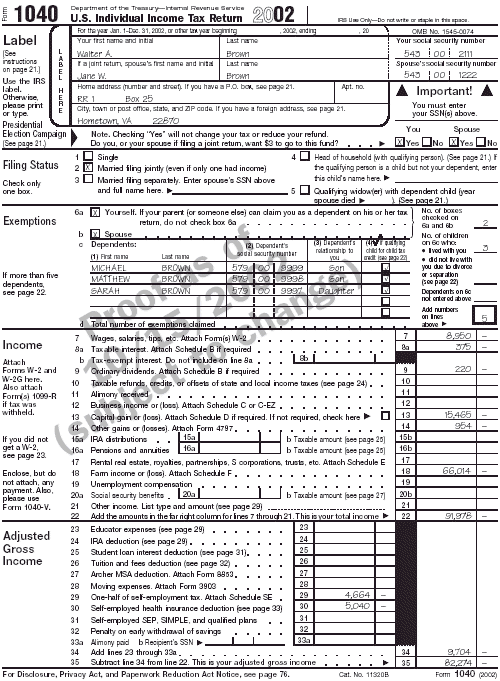
Form 1040 - page 1
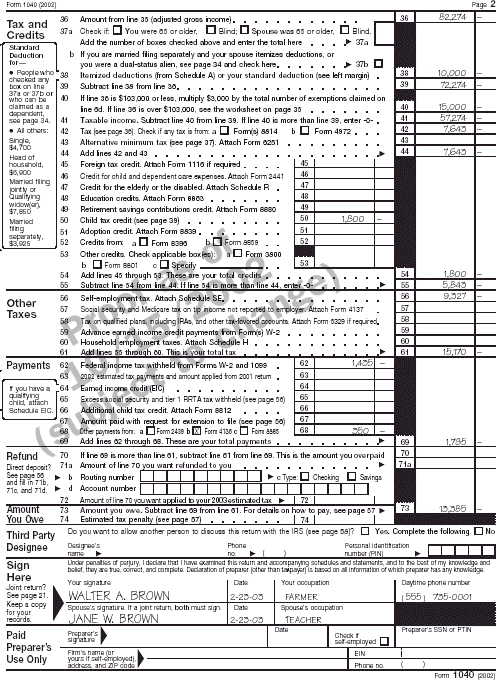
Form 1040 - page 2
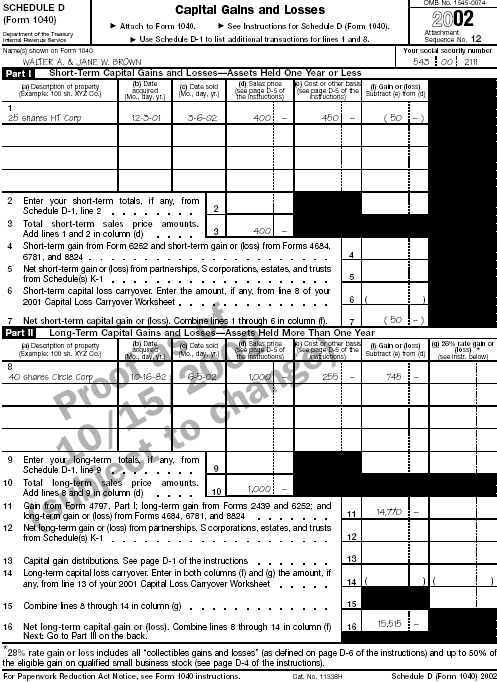
Schedule D (Form 1040) - page 1
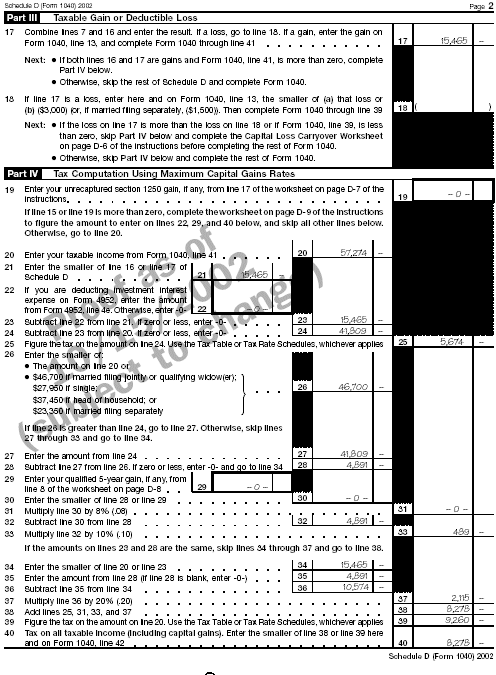
Schedule D (Form 1040) - page 2
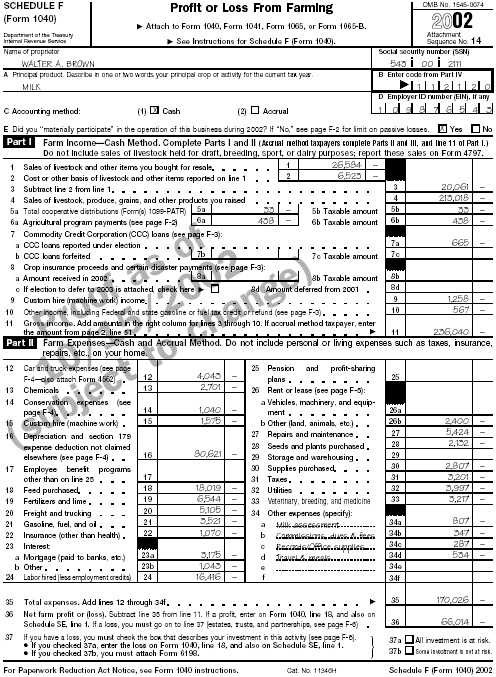
Schedule F (Form 1040) - page 1
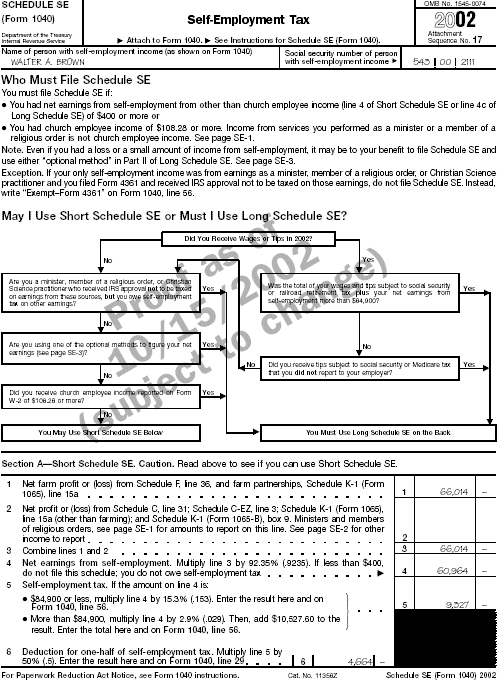
Schedule SE (Form 1040) - page 1
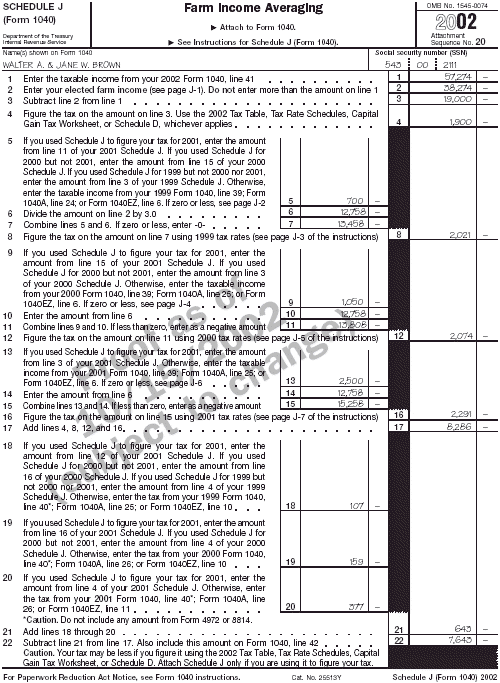
Schedule J (Form 1040) - page 1
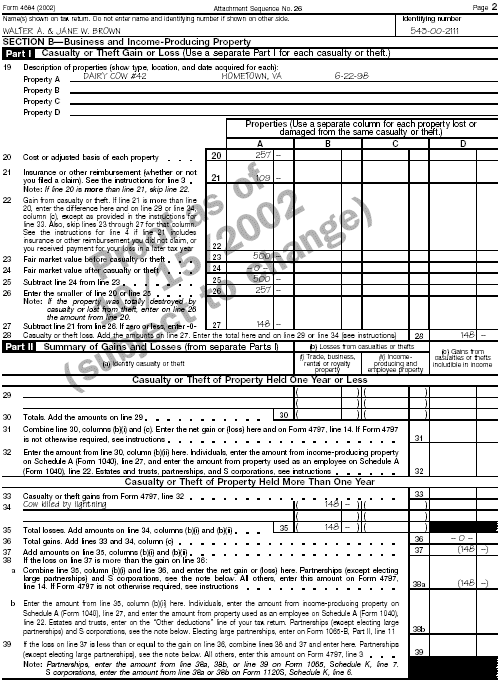
Form 4684 - page 2
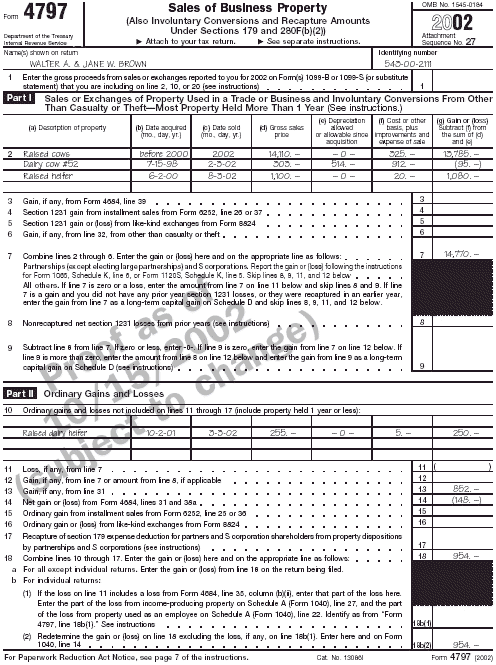
Form 4797 - page 1
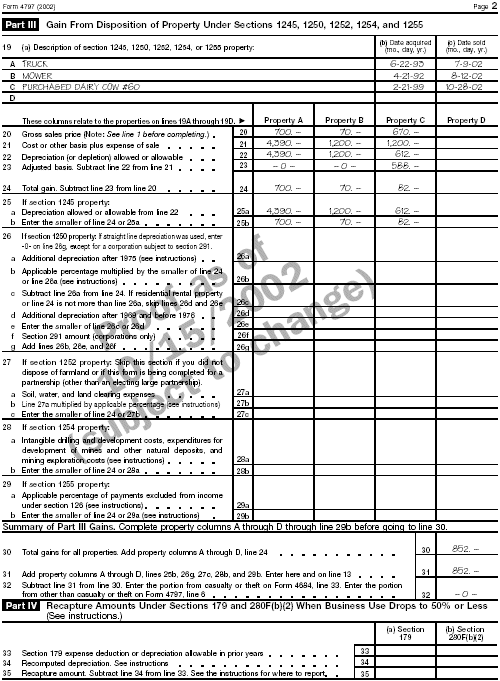
Form 4797 - page 2
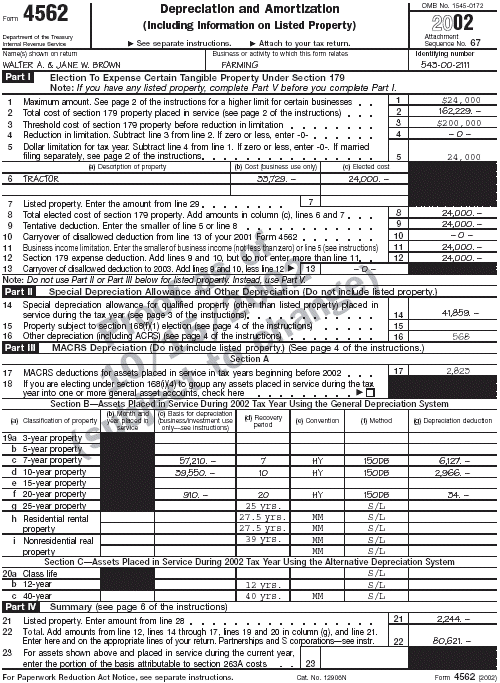
Form 4562 - page 1
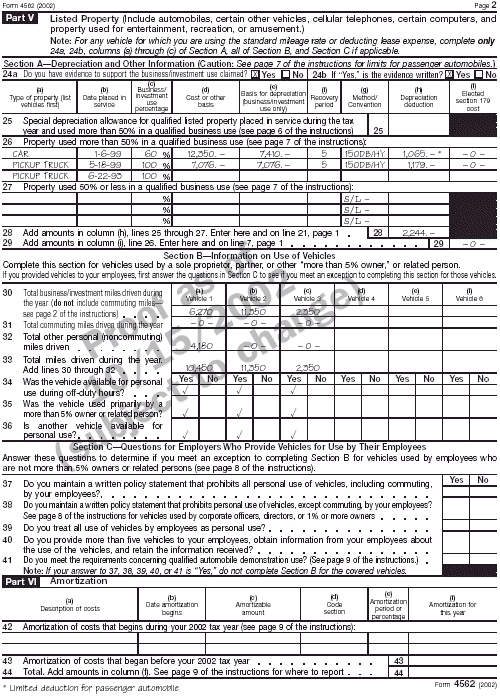
Form 4562 - page 2
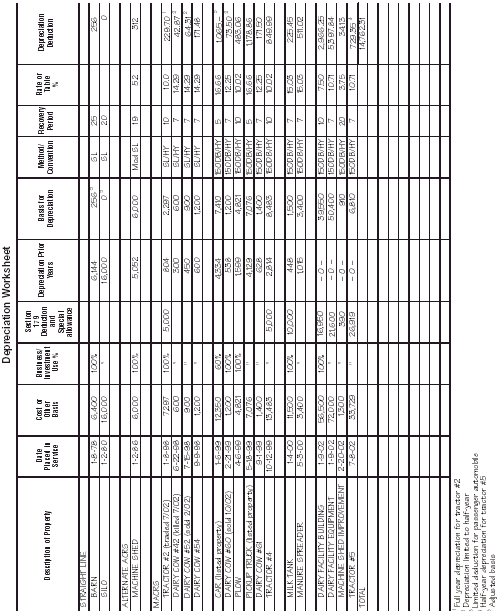
Depreciation Worksheet
- Continue - |